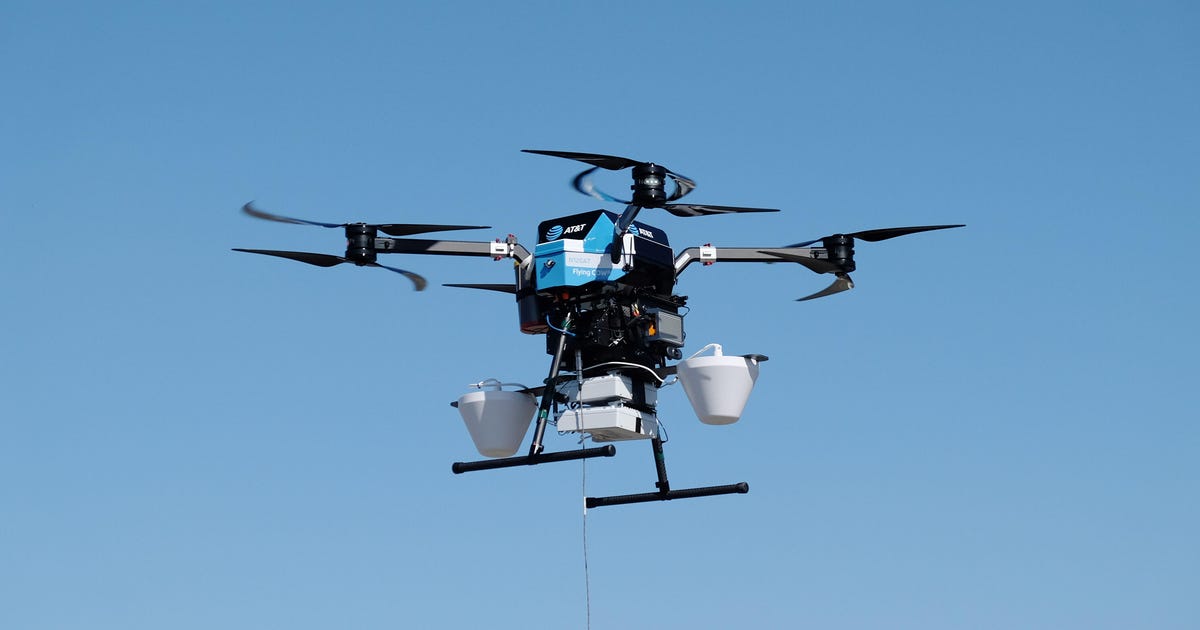These AT&T Drones Could Give You 5G Network Service When the Next Hurricane Strikes
What’s happening
Drones that AT&T flies during disasters are getting 5G network technology that should make them more effective for the public and first responders.
Why it matters
Climate change makes hurricanes, floods and wildfires more frequent, and we rely on our smartphones more and more during disasters.
AT&T has begun upgrading the drones it flies into disaster areas with 5G networks, an improvement that’s expected to increase the chances your phone can send a text message or download evacuation plans when conventional mobile networks collapse.
Over the past few years, the US carrier has stabilized coverage at disaster sites by driving in trucks called COWs, or cell on wheels. It later expanded the approach with a fleet of flying COWs, or cell on wings, that provide network service to larger areas.
Last month, AT&T began testing its first 5G-equipped flying COWs so its aerial networks ultimately can connect to more people and devices than with earlier 4G technology. Its test took place in a remote part of Missouri, far from any other mobile networks.
“It was challenging finding an area that didn’t have connectivity,” Art Pregler, AT&T’s drone leader, said in an exclusive interview. “We were trying to find an area where there was no signal at all so we could be assured that all the signal we were capturing was from our drone.”
AT&T expects its 5G flying COWs to be available in about a month as the company upgrades its drones and the fiber optic tethers that link them to the trucks that serve as communication and power bases. The drones are staged already in warehouses, ready for use. “We have them on the West Coast for fire season, in the Southeast for hurricane season and in the Midwest for flood season,” Pregler said.
The need for disaster response technology might seem remote. But as climate change spurs more extreme weather, the chances your network could go down rise along with the likelihood of wildfires, hurricanes, flooding and other problems that wreck conventional communications just when you need them most.
“Emergency preparedness and disaster recovery for the carriers has become critically important,” Technalysis Research analyst Bob O’Donnell said. “These COWs literally become a lifeline.”
5G, short for fifth generation mobile networking, is a collection of technologies designed to improve the speed and responsiveness of your smartphone’s connection. The industry is a few years into the 5G transition, an expensive upgrade to the cellphone base stations your phone connects to when you’re away from the Wi-Fi signal at your home or office.
By AT&T’s estimates, one of 5G’s biggest benefits is higher data transfer speeds that are useful when watching video, downloading app updates or uploading photos. Another is lower latency, which means services on the network are more responsive. It’s also capable of handling more devices on the network, an important upgrade given the spread of smartphones and the fact that we increasingly connect cars, smartwatches and other communication gear to mobile networks.
In its first 5G flying COW test, AT&T was able to cover about 10 square miles with one drone hovering 300 feet up. The drone connected to a satellite and delivered download speeds of 46Mbps and upload speeds of 71Mbps, a respectable if not blazing speed.
The purpose of the test wasn’t to maximize data speeds, though, so don’t read too much into those numbers beyond the fact that it worked.
AT&T has used its flying COWs after real disasters, notably hurricanes like Hurricane Maria in Puerto Rico in 2017 and Hurricane Florence in North Carolina in 2018. When the Category 4 Hurricane Michael struck Florida in 2018, flying COWs provided network connections to first responders looking for survivors. “For a while we were the only network that was operational there at ground zero,” Pregler said.
AT&T has an extra incentive for network service during disasters: It runs the network behind FirstNet, a service for first responders like police and fire crews.
Other carriers are investing to prepare for disasters, too, for example by staging network equipment ahead of time when hurricanes are coming. Verizon in 2021 showed off Thor, a hulking truck that’s a mobile 5G base station. And T-Mobile has its own portable network vehicles, satellite cells on wheels and satellite cells on light trucks. It’s also hardening its networks and adding more backup generators in case of power loss.
AT&T expects to tap into one 5G option, high-frequency radio waves called millimeter wave, or mmWave, to dramatically increase data transfer speeds, to improve its flying COWs. The shorter-range mmWave technology offers dramatic speeds beyond 1Gbps.
The flying COWs won’t use mmWave for connecting your smartphone but will use it to help strengthen the network overall, Pregler said. Specifically, mmWave connections will link multiple drones into a sort of mesh network in the sky to extend the flying COW coverage.
The COW technology itself can connect to the network in up to six simultaneous ways, including fiber optic links and satellites in low Earth orbit or higher in geostationary orbit, Pregler said.
Although AT&T expects improvements with 5G COWs, the new network technology hasn’t yet hasn’t lived up to all its initial hype.
But as carriers upgrade their networks, expand to new midband radio spectrum and improve the 5G standard itself, better results are likely to follow. So are new network services like wireless home broadband and always-connected PCs.
For emergency services, 5G’s improved ability to handle lots of devices is important, O’Donnell said. “Moving it to 5G is going to make it significantly better.”
For all the latest world News Click Here

